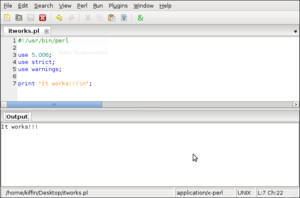As you have probably already noticed, I recently implemented a random banner to be displayed on the main page of my website. By clicking refresh a few times you can see it working. Slowly but surely I will add more banners to my collection. It's an elegant way of enabling such a feature, so I thought that it'd be nice to share it with anyone interested.
Basically I create and then keep a bunch of 905x170 pictures which I save in the images directory. These can be randomly displayed in the banner div#homepage-image which is inserted using the /cgi-bin/rand-banner.pl random banner generator script.
This is made possible by including the following lines in the css file:
/* custom.css */
...
/* Banner is randomly generated */
#homepage-image { background-image: url('/cgi-bin/rand-banner.pl'); }
...
This script is run automatically every day by including the following line in the crontab:
@daily /www/kiffingish.com/cgi-bin/rand-banner.pl crontab
For those interested, I have also included the perl script which does all of the magic. It should be pretty straight-forward what this script does, which shows you the power of perl.
#!/usr/bin/perl
use strict;
use warnings;
# rand-banner.pl [crontab] :
# If called with 'crontab' just create the file list of banners,
# otherwise return the binary contents of a random banner immage
# for displaying on a web page.
use CGI;
my $cgi = new CGI;
# Directories based from root dir.
my $root_dir = "/path/to/root/dir";
my $cgi_dir = "$root_dir/cgi-bin";
my $doc_dir = "$root_dir/docs";
my $img_dir = "$doc_dir/images";
my $banners_lst = "banners.lst";
# Coversion file ext to http img/type.
my %ext2typ = ( bmp => 'bmp',
gif => 'gif',
jpeg => 'jpeg',
jpg => 'jpeg',
png => 'png',
tif => 'tiff',
tiff => 'tiff',
);
# Only interested in the following file types.
my $img_filter = join(',', keys %ext2typ);
# If called with 'crontab' or banners.lst does not exist, collect
# list of banners from 905x170 files in images directory.
my $crontab = (defined($ARGV[0]) && ($ARGV[0] eq 'crontab'));
if ($crontab || (! -f $banners_lst)) {
# See: http://www.imagemagick.org/script/identify.php
my $output = `identify $img_dir/*.{$img_filter} 2>/dev/null |grep ' 905x170 ' | sed 's/\\[.*//' | sed 's/^.*\\///'`;
open my $fh, ">", $banners_lst or die "Cannot open file '$banners_lst' for writing ($!)";
print $fh $output;
close $fh;
}
# All done if called from crontab.
exit if $crontab;
# Grab the latest banner list.
open my $fh, "<", $banners_lst or die "Cannot open file '$banners_lst' for reading ($!)";
my @banners = <$fh>;
close $fh;
# Take a random item from the list.
my $banner = $banners[rand @banners];
chomp($banner);
# Define banner image filepath.
$banner =~ /^.*\.(.*)$/;
my $ext = $1;
my $img = "$img_dir/$banner";
# Get the binary contents of the image file.
open (IMAGE, $img) or die "Cannot open image file '$img' for reading ($!)";
my $size = -s $img;
my $data;
read IMAGE, $data, $size;
close (IMAGE);
# Return image data to the caller. Be sure to disable caching so
# that each new request returns a new banner image.
print "Content-type: image/$ext2typ{$ext}\n";
print "Cache-Control: max-age=0, no-cache, no-store, must-revalidate\n";
print "Pragma: no-cache\n";
print "Expires: Wed, 11 Jan 1984 05:00:00 GMT\n";
print "\n";
print $data;
This might seem like alot of work for something very simple, but the challenge was worth it for me. I kind like this little added feature to my website. Have fun using it.














Recent Comments
- Charles
- jpmcfarlane
- Kiffin
- jpmcfarlane
- KathleenC